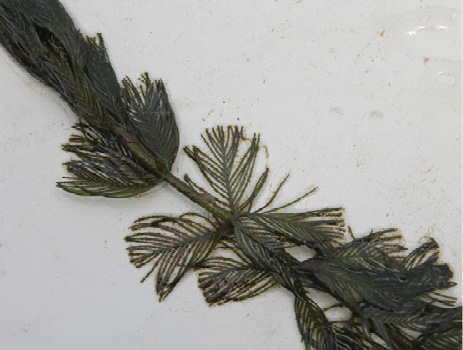Watermilfoil | Myriophyllum spp.
Submersed | Native and Non-Native



Watermilfoils are rooted, submersed plants with characteristic feather-like leaves under the water. There are several species, including native (e.g., variable-leaf watermilfoil; Myriophyllum heterophyllum) and non-native (Eurasian watermilfoil; M. spicatum), but all have potential to be invasive in Mississippi ponds. Milfoil species can easily hybridize, which complicates identification efforts.
Variable-leaf watermilfoil has leaves in whorls of four to six, with submersed leaves exhibiting a feathery appearance. Emergent leaves are solid, sword-shaped, and firmer. Submersed leaves are usually spaced about 0.75 inch apart, and stems are thicker than M. spicatum. Fruits are disk-shaped.
Eurasian watermilfoil has leaves in whorls of three to five and much more tightly packed than M. heterophyllum (spacing less than 0.1 inch between whorls). It does not have emersed sword-shaped leaves. Fruits are four-lobed and spherical.
Eurasian watermilfoil is the more likely species to cause problems for Southern landowners. It is highly aggressive and forms dense colonies that create surface mats in ponds, clog intake pipes, and interfere with dissolved oxygen production.
Management Value
Highly invasive and aggressive. Eradicate on first detection.
Recommended Controls
Option 1: Florpyrauxifen-benzyl (0.0052-pound formulation). Florpyrauxifen-benzyl (9.6 ounces per acre-foot of water) should be applied as a submersed injection (application using a wand or hose). Determine pond volume prior to application. Do not exceed annual herbicide rate limits as stated on the product label.
Option 2: Endothall (4.23-pound formulation). Endothall should be applied as a submersed injection (1.92 gallons per acre-foot of water). Determine pond volume prior to application. Do not exceed annual herbicide rate limits as stated on the product label.
Option 3: 2,4-D (3.8-pound formulation). 2,4-D should be applied as a submersed injection (0.75 gallon per acre-foot of water). Determine pond volume prior to application. Do not exceed annual herbicide rate limits as stated on the product label.
Option 4: Diquat (3.73-pound formulation). Diquat should be applied as a submersed injection (0.25 gallon per acre-foot of water). Determine pond volume prior to application. Do not exceed annual herbicide rate limits as stated on the product label.
NOTE: Acre-foot = average depth of pond multiplied by pond acreage; average depth is calculated by taking the depth at 20 points across a water body and averaging the values.
Treat ponds when the plants are actively growing and the water temperature is at least 60˚F. It would be best to treat one-third of the pond at a time for larger water bodies, with 2 weeks or more separating applications. After the entire pond has been treated, a repeat whole-pond application may be necessary to eliminate remaining plants.
Read and follow all chemical label instructions, especially the section on the use of personal protection equipment.
Photo Credits Top: Leslie J. Mehrhoff, University of Connecticut, Bugwoord.org; Middle: U.S. Geological Survey.

The information given here is for educational purposes only. References to commercial products, trade names, or suppliers are made with the understanding that no endorsement is implied and that no discrimination against other products or suppliers is intended.
Publication 3735-13 (POD-11-23)
By Wes Neal, PhD, Extension/Research Professor, Wildlife, Fisheries, and Aquaculture; Dennis Riecke, Fisheries Coordinator, Mississippi Department of Wildlife, Fisheries, and Parks; and Gray Turnage, PhD, Assistant Research/Extension Professor, GeoSystems Research Institute.
The Mississippi State University Extension Service is working to ensure all web content is accessible to all users. If you need assistance accessing any of our content, please email the webteam or call 662-325-2262.



